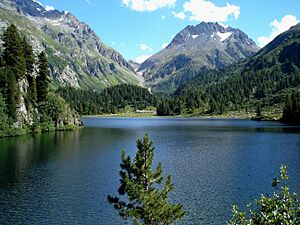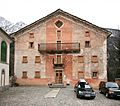Stampa facts for kids
Quick facts for kids
Stampa
|
||
|---|---|---|
|
||
| Country | Switzerland | |
| Canton | Graubünden | |
| District | Maloja | |
| Area | ||
| • Total | 94.74 km2 (36.58 sq mi) | |
| Elevation | 994 m (3,261 ft) | |
| Population | ||
| • Total | 595 | |
| • Density | 6.280/km2 (16.266/sq mi) | |
| Postal code |
7605
|
|
| Surrounded by | Bivio, Bondo, Chiesa in Valmalenco (IT-SO), Sils im Engadin/Segl, Soglio, Val Masino (IT-SO), Vicosoprano | |
Stampa used to be a town, also called a municipality, in the Maloja area of the Swiss canton called Graubünden. It is now part of a bigger municipality named Bregaglia.
Contents
A Look Back: Stampa's History
Stampa was first written about after the year 1354. It was called Stamppa back then. The town got its name from the powerful Stampa family. They were like the rulers or "overlords" of this area for a long time.
Exploring Stampa's Geography
Stampa covers an area of about 94.7 square kilometers (about 36.6 square miles). This information is from 2006.
- About 14% of this land is used for farming.
- Nearly 19% is covered by forests.
- Only a small part, less than 1%, has buildings or roads.
- The rest, about 66%, is made up of natural features like rivers, glaciers, or mountains.
Stampa is located in the Bergell sub-district, which is part of the Maloja district. It's an important place for both the government and culture in this sub-district.
The town is split into two main parts:
- A smaller part is in the Val Bregaglia valley.
- A larger part stretches out from both sides of the Maloja Pass and the Engadin area.
The municipality includes several small villages and areas. These are Stampa, Borgonovo, Coltura, Montaccio, and Caccior. Caccior is located at about 1,000 meters (3,280 feet) above sea level. Other areas are Cavril and Canova, which are at the bottom of the Maloja Pass (about 1,600 meters or 5,250 feet high). There are also parts of Maloja, including Isola, Orden, Pila, and Capolago, which are even higher at about 1,810 meters (5,940 feet).
On January 1, 2010, Stampa joined with four other towns. These were Bondo, Castasegna, Soglio, and Vicosoprano. They all became one new municipality called Bregaglia.
You can find a lake called Lägh da Cavloc in the Val Forno area.
People of Stampa: Demographics
In 2008, Stampa had a population of 595 people. About 14.5% of these people were from other countries. Over the past 10 years, the number of people living in Stampa has gone down slightly, by about 2.6%.
In the year 2000, there were a little more girls and women than boys and men. About 48.4% of the population was male, and 51.6% was female.
Here's a look at the age groups in Stampa in 2000:
- 65 children (12.2%) were between 0 and 9 years old.
- 40 teenagers (7.5%) were 10 to 14 years old.
- 21 teenagers (4.0%) were 15 to 19 years old.
- 41 adults (7.7%) were 20 to 29 years old.
- 70 adults (13.2%) were 30 to 39 years old.
- 84 adults (15.8%) were 40 to 49 years old.
- 71 adults (13.4%) were 50 to 59 years old.
- 69 older adults (13.0%) were 60 to 69 years old.
- 44 older adults (8.3%) were 70 to 79 years old.
- 23 very old people (4.3%) were 80 to 89 years old.
- 3 very old people (0.6%) were 90 to 99 years old.
In the 2007 national election in Switzerland, the SVP was the most popular party. They received 57.2% of the votes. Other popular parties were the SP (22.5%), the FDP (16.2%), and the CVP (2.6%).
Most people in Switzerland have a good education. In Stampa, about 65% of adults (aged 25-64) have finished either high school or gone on to higher education, like a university.
Stampa has a low unemployment rate of 1.71%. In 2005, there were 24 people working in farming and related businesses. There were 64 people working in manufacturing and construction. The largest group, 191 people, worked in service jobs like shops, hotels, or offices.
Here's how Stampa's population has changed over the years:
| year | population |
|---|---|
| 1850 | 328 |
| 1900 | 445 |
| 1950 | 414 |
| 2000 | 531 |
Languages Spoken in Stampa
Most people in Stampa speak Italian. In 2000, about 66.1% of the population spoke Italian. German was the second most common language, spoken by 27.7% of people. A smaller group, 1.9%, spoke Romansh.
Because parts of Stampa are in different valleys (Engadin and Val Bregaglia), there are also groups of people who speak German and Romansh.
Here's a table showing the languages spoken in Stampa over different years:
| Languages | Census 1980 | Census 1990 | Census 2000 | |||
|---|---|---|---|---|---|---|
| Number | Percent | Number | Percent | Number | Percent | |
| German | 66 | 15.71% | 139 | 28.48% | 147 | 27.68% |
| Romansh | 21 | 5.00% | 12 | 2.46% | 10 | 1.88% |
| Italian | 317 | 75.48% | 319 | 65.37% | 351 | 66.10% |
| Population | 420 | 100% | 488 | 100% | 531 | 100% |
Famous People from Stampa
Stampa is known as the home of the Giacometti family, who were all famous artists. Here are some of the most well-known members:
- Giovanni Giacometti (1868–1933)
- Augusto Giacometti (1877–1947), who was Giovanni's cousin
- Alberto Giacometti (1901–1966), Giovanni's son
- Diego Giacometti (1902–1985), another of Giovanni's sons
- Bruno Giacometti (1907-2012), also Giovanni's son
Another famous artist, Miriam Cahn, who was born in Basel, has lived in Stampa since 2016. She works from a special art studio built by a local architect named Armando Ruinelli.
Important Buildings: Heritage Sites
Palazzo Castelmur is a very important building in Stampa. It is listed as a Swiss heritage site of national significance. This means it's a special place that is protected because of its history and culture.
See also
 In Spanish: Stampa para niños
In Spanish: Stampa para niños








